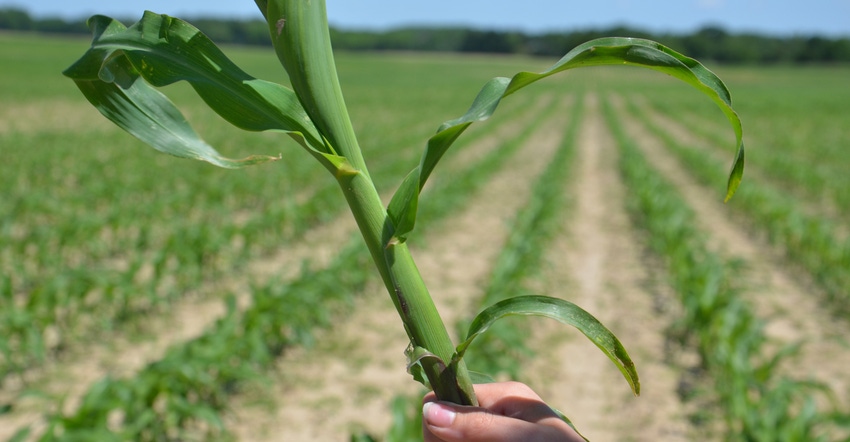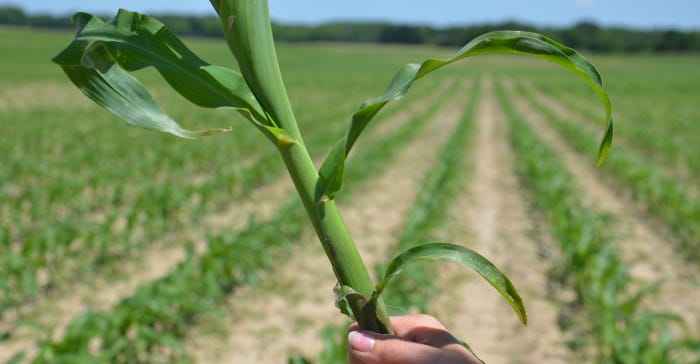
Look at the cornstalk pictured below, removed from the cornfield shown behind it. Suppose you’re about to spray a herbicide that must be applied by V4 according to the leaf collar method. Could you still apply the herbicide on this corn?
Dave Nanda, an independent crops consultant based in Indianapolis, says yes. The plant appears to have four leaves with collars, counting the first leaf that emerged on the lower left. More leaves are emerging at the top, but they don’t have collars yet.
“If you count leaves without collars, you would likely wind up with five-leaf corn, and you would think you couldn’t apply and still be on the label,” Nanda says. “In reality, you would still be OK. It’s important to understand crop growth stages and how it works.”

WHAT STAGE? Counting the small leaf on the lower left, this corn is at V4.

Key definitions
Here are some important definitions related to growth staging of corn. Some of this information comes from the Purdue University Corn & Soybean Field Guide. It’s published by Purdue’s Crop Diagnostic Training and Research Center, where Corey Gerber is the director.
VE stage. This is also called emergence. “V” simply refers to vegetative. When corn reaches the reproductive stage, remaining stages begin with “R” for reproductive. At VE, no leaf collars are visible.
Leaf collar. A leaf collar is a light-green to slightly yellow band of tissue at the junction of the leaf blade and leaf sheath near the stem of the plant.
Leaf collar method. This staging method, used by most university researchers, only counts leaves with visible collars.
Droopy leaf method. This staging method ignores collars. Instead, it counts all leaves. The last leaf counted to determine growth stage is the uppermost leaf that is 40% to 50% emerged from the whorl. The leaf tip of the last leaf counted is usually beginning to droop downward. Insurance adjustors often use this method. Defoliation tables are typically based on the droopy leaf method.
V1 stage. This stage occurs when the first true leaf emerges through the soil. According to the Purdue guide, the first true leaf has a rounded tip. Later leaves always end in a pointed tip.
Growing point. One reason for staging corn is to know when the growing point is above the ground. It typically doesn’t come aboveground until corn is at the V5 or five-leaf stage, using the leaf collar method. Until the growing point comes aboveground, Nanda says, corn is at less risk from things like a late frost or hail. Leaves aboveground could be destroyed, but the plant can still regrow from the growing point. Once the growing point is aboveground, the plant is vulnerable to damage from these elements.
“Late” stage. When describing the growth stage of an entire field, agronomists typically refer to the stage of over half the plants in the field. For example, if 60% are at V5 and 40% are already at V6, the agronomist might say the field is at the “late V5” stage.
Seed Genetics-Direct, Washington Court House, Ohio, is sponsor of Corn Watch ’17.
About the Author(s)
You May Also Like




